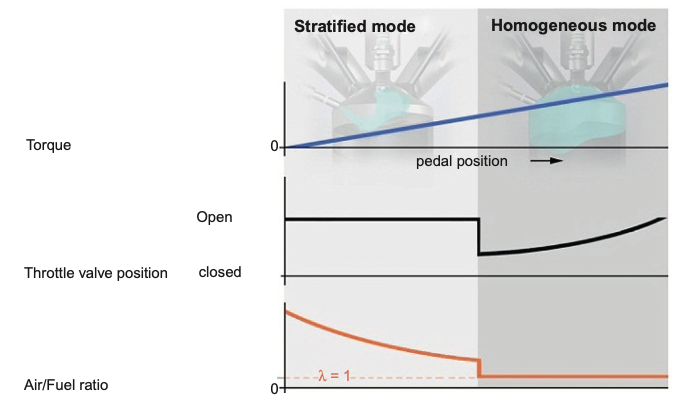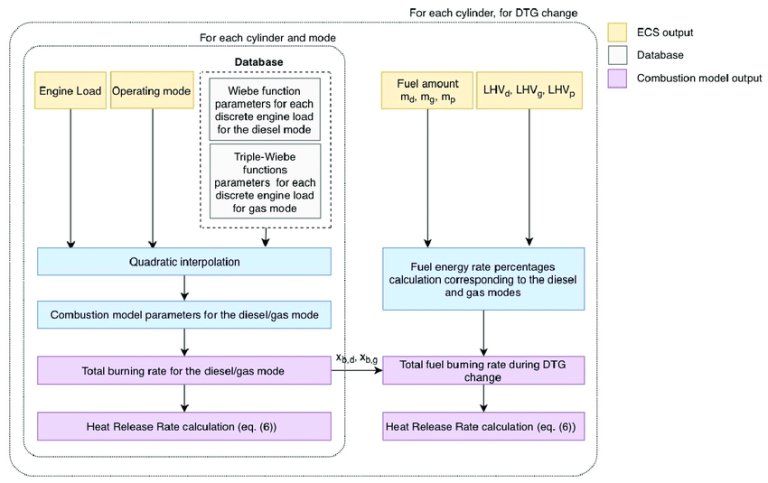Switching between operating modes depending on engine load is a common technique used in modern internal combustion engines to optimize fuel efficiency and reduce emissions. This technique involves adjusting the engine’s operating mode based on the current engine load.
Engine load is a measure of how much work the engine is currently doing. It is typically measured in terms of throttle position, which is the percentage of the engine’s maximum air intake capacity that is currently being used. For example, if the throttle is fully open, the engine is operating at maximum load, while if the throttle is closed, the engine is operating at minimum load.
There are two main operating modes that engines use: the lean-burn mode and the stoichiometric mode. In the lean-burn mode, the engine uses a lean air-fuel mixture, which means that there is more air than fuel in the mixture. This reduces the amount of fuel that is burned, which in turn reduces emissions. However, the lean-burn mode is less efficient than the stoichiometric mode at high engine loads, which is why engines switch to the stoichiometric mode at high loads.
In the stoichiometric mode, the engine uses a mixture of air and fuel that is precisely balanced to provide the optimal amount of fuel for complete combustion. This mode is more efficient at high engine loads because it allows the engine to burn more fuel, which produces more power. However, it also produces more emissions than the lean-burn mode, which is why engines switch back to the lean-burn mode at low engine loads.
Modern engines use sophisticated engine control units (ECUs) to monitor engine load and adjust the operating mode accordingly. The ECU uses a variety of sensors to measure engine load, including the throttle position sensor, the mass airflow sensor, and the oxygen sensor. Based on these measurements, the ECU adjusts the air-fuel ratio and ignition timing to optimize performance and emissions.
In addition to switching between lean-burn and stoichiometric modes, some engines also use other techniques to optimize fuel efficiency and reduce emissions. For example, some engines use cylinder deactivation, which shuts down some of the engine’s cylinders when they are not needed. This reduces the amount of fuel that is burned, which in turn reduces emissions.
In conclusion, switching between operating modes depending on engine load is an effective technique for optimizing fuel efficiency and reducing emissions in modern internal combustion engines. By adjusting the engine’s operating mode based on the current engine load, engines can achieve the optimal balance between performance and emissions. With the help of sophisticated engine control units and a variety of sensors, modern engines can operate more efficiently and cleanly than ever before.

The air-fuel mixture is the combination of air and fuel that is mixed together and burned in the engine. The ideal air-fuel ratio for complete combustion is known as the stoichiometric ratio, which is about 14.7 parts of air to 1 part of fuel by mass. At this ratio, all the fuel is burned completely, producing only carbon dioxide (CO2) and water (H2O) as byproducts.
However, operating at this ideal ratio is not always practical or efficient for internal combustion engines. At low engine loads, running the engine at the stoichiometric ratio can lead to incomplete combustion, as the fuel may not be able to mix completely with the air. This can result in unburned fuel and increased emissions of carbon monoxide (CO) and hydrocarbons (HC).
On the other hand, running the engine at a lean air-fuel ratio (more air, less fuel) can reduce emissions of CO and HC, but can also cause the engine to run hotter and produce more nitrogen oxides (NOx) due to the higher combustion temperatures. This is where switching between operating modes comes in – by optimizing the air-fuel ratio depending on the engine load, engines can achieve better efficiency and reduce emissions.
In the lean-burn mode, the engine runs with a leaner air-fuel ratio, typically around 16 to 20 parts of air to 1 part of fuel by mass. This results in reduced fuel consumption and lower emissions of CO and HC, which is desirable at low engine loads. However, lean-burn combustion can also cause higher levels of NOx emissions, which is why this mode is typically used at low to medium engine loads.
In contrast, at high engine loads, switching to the stoichiometric mode allows the engine to run at the ideal air-fuel ratio. This results in better combustion efficiency and higher power output, which is desirable for performance. However, it also results in increased emissions of CO, HC, and NOx.
By switching between these modes depending on engine load, modern engines can optimize performance and emissions while minimizing fuel consumption. This is done through advanced engine control systems that continuously monitor various engine parameters and adjust the air-fuel ratio, ignition timing, and other factors to maintain optimal engine operation.
In addition, other techniques such as cylinder deactivation, variable valve timing, and direct injection can also be used to further optimize engine operation and efficiency. Overall, the goal is to achieve a balance between performance and emissions that meets regulatory requirements while providing the best possible fuel economy for the vehicle.
Advantages of switching between operating modes depending on engine load:
- Improved fuel efficiency: By optimizing the engine’s operating mode depending on the engine load, modern engines can achieve better fuel efficiency. This is because the engine can adjust its air-fuel ratio and other parameters to match the engine load, which minimizes waste and reduces fuel consumption.
- Reduced emissions: Switching between lean-burn and stoichiometric modes can help to reduce emissions of pollutants such as CO and HC. The lean-burn mode produces less CO and HC emissions at low engine loads, while the stoichiometric mode produces lower NOx emissions at high engine loads.
- Better performance: By switching to the stoichiometric mode at high engine loads, the engine can achieve higher power output and better performance. This is because the engine can burn more fuel to produce more power.
- Regulatory compliance: Modern engines are subject to increasingly strict emissions regulations, and switching between operating modes depending on engine load can help to meet these regulations while providing the best possible fuel economy.
Disadvantages of switching between operating modes depending on engine load:
- Complexity: The engine control systems required to switch between operating modes can be complex and expensive. They require a variety of sensors, actuators, and software to monitor engine parameters and adjust operating modes accordingly.
- Increased maintenance: With more complex systems comes the potential for more maintenance and repair issues. If the engine control system or sensors fail, the engine may not operate optimally and fuel efficiency and emissions could suffer.
- Reduced durability: Switching between lean-burn and stoichiometric modes can also have an impact on engine durability. Lean-burn combustion can cause higher temperatures and increased wear on engine components, while stoichiometric combustion can produce more exhaust heat and higher levels of NOx emissions, which can also contribute to component wear.
- Higher cost: The cost of implementing a sophisticated engine control system can be significant, which may make it less accessible to some consumers. Additionally, the increased complexity and maintenance requirements can also increase the cost of ownership over the life of the vehicle.
In conclusion, while there are clear advantages to switching between operating modes depending on engine load, there are also potential drawbacks that must be considered. Ultimately, the decision to use this technique will depend on a variety of factors, including the specific engine design, regulatory requirements, and consumer demand for fuel-efficient and low-emission vehicles.










